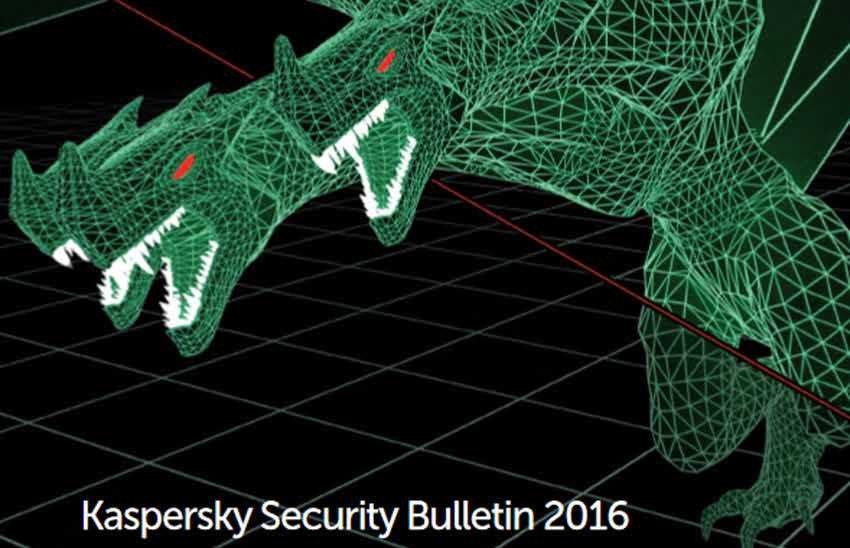Kaspersky: Το 2016, οι μεγαλύτερες ψηφιακές απειλές παγκοσμίως αφορούσαν τα χρηματοοικονομικά, τις πληροφορίες και την επιθυμία αναστάτωσης και παραβίασης δεδομένων. Αυτές περιλάμβαναν το παράνομο εμπόριο δεκάδων χιλιάδων στοιχείων σύνδεσης από παραβιασμένους servers, interception of ATM systems, programs ransomware, malware programs for mobile banking systems, as well as cyber espionage attacks, but also the breach and leakage of sensitive personal data. 
These negative trends, their effects and the data they contain are covered by the annual one Report Kaspersky Security Bulletin Review And the Statistical References her.
2016's Kaspersky Lab research also reveals the extent to which businesses are struggling to locate a security incident quickly and effectively: 28,7% of businesses reported that it took them several days to spot such an event, while 19% admitted it took weeks, if not more time. For a small but significant minority of 7,1%, tracking lasted months. Among those who "fought" more often, the problem is often detected by internal or external security checks, or by third party alerts, such as by a customer or a consumer. More information on how late the detection of threats affects the recovery costs of the business, you can find in SUMMARY OF MAIN POINTS of the report.
Other things we learned about 2016:
- The shadow economy is bigger and more sophisticated than ever: just look at it xDedic - the shadow market for over 70.000 connection data from infringing servers that allowed anyone to buy access to a broken server, such as someone on a government network in an EU country for just $ 6
- The largest financial robbery did not include stock trading, as expected: instead, SWIFT transactions were used to steal 100 million dollars.
- Critical infrastructures are alarmingly vulnerable in many places, as revealed at the end of 2015 and its principles 2016 through the digital assault BlackEnergy in Ukraine's energy sector, which included shutting down the electricity grid, deletion data and launching a DDoS attack. In 2016, Kaspersky Lab experts investigated the possibilities of industrial control threats and discovered thousands of providers worldwide exposed to the Internet, with 91,1% have vulnerabilities which one can manage remotely.
- A targeted attack may not follow any pattern: as it was shown by ProjectSauron APT, an advanced, modular digital espionage team that adapted its tools according to each goal, reducing their value as Indices of Compromise (IOCs) for any other victim.
- The electronic release of huge volumes of data can directly affect what people think and believe: as evidenced by ShadowBrokers and personal and political data leaks.
- A webcam or a DVD player could be part of a world-wide digital army of Internet-of-things: as the year ends, it is clear that the attacks related to Mirai botnet is just the beginning.
“The number and range of digital attacks και των θυμάτων τους που συναντήσαμε το 2016, εγείρουν το θέμα της καλύτερης ανίχνευσης στην κορυφή της ατζέντας των επιχειρήσεων. Η ανίχνευση είναι τώρα μια πολύπλοκη διαδικασία που απαιτεί τεχνογνωσία στον τομέα της ασφάλειας, βαθιά γνώση του τοπίου των απειλών, αλλά και την ανάπτυξη δεξιοτήτων για να εφαρμοστεί η τεχνογνωσία αυτή σε κάθε οργανισμό. Η ανάλυσή μας επάνω στις ψηφιακές απειλές όλα αυτά τα χρόνια έχει φέρει στην επιφάνεια τόσο συγκεκριμένα μοτίβο όσο και μοναδικές προσεγγίσεις. Αυτή η συσσωρευμένη κατανόηση στηρίζει ενεργά τα εργαλεία άμυνάς μας, καθώς πιστεύουμε ότι οι technologies προστασίας θα πρέπει να τροφοδοτούνται από την τεχνογνωσία στον τομέα της ασφάλειας. Επίσης, έγκειται στο επίκεντρο του αυξανόμενου αριθμού εταιρικών μας σχέσεων και συνεργασιών. Χρησιμοποιούμε το παρελθόν για να προετοιμαστούμε για το μέλλον, έτσι ώστε να μπορούμε να συνεχίσουμε να προστατεύσουμε τους πελάτες μας από προηγουμένως άγνωστες απειλές, πριν προλάβουν να προκαλέσουν οποιαδήποτε ζημιά» said David Emm, Principal Security Researcher Kaspersky Lab.
In a special video on Youtube you can see the overview of information security protection.
The remarkable statistics for the year 2016 include:
- 36% of online banking attacks are now targeting Android devices, compared to just 8% 2015
- 262 million URLs were identified as malicious by Kaspersky Lab products, and there were 758 million malicious cyber-attacks worldwide - with one in three (29%) coming from the US and 17% from the Netherlands
- There were eight new "families" of malware for Point-of-Sale and ATM - an increase of 20% compared to 2015
- Attackers have used the Google Play Store to distribute malware for Android devices, with "infected" applications having "gone down" hundreds of thousands of times





